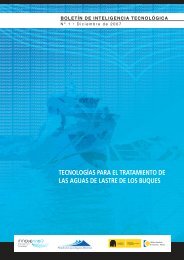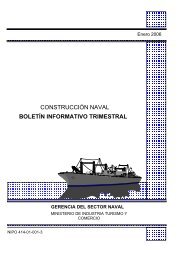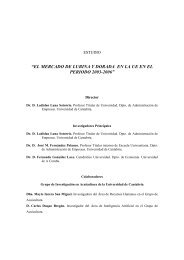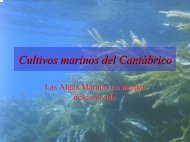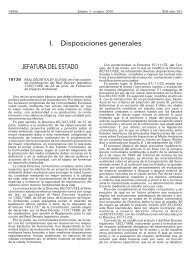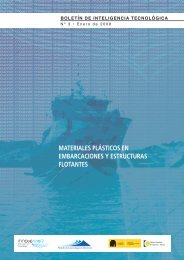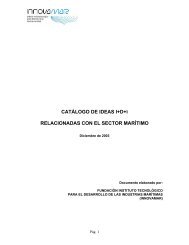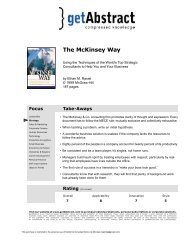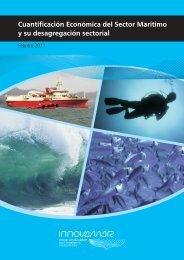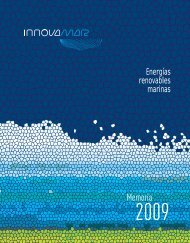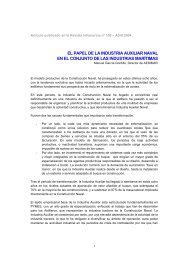N2 Antifouling.pdf
N2 Antifouling.pdf
N2 Antifouling.pdf
Create successful ePaper yourself
Turn your PDF publications into a flip-book with our unique Google optimized e-Paper software.
BOLETÍN DE INTELIGENCIA TECNOLÓGICA<br />
Nº 2 • Diciembre de 2007<br />
PINTURAS Y RECUBRIMIENTOS ANTIFOULING
PINTURAS Y RECUBRIMIENTOS ANTIFOULING<br />
INTRODUCCIÓN 3<br />
LISTADO DE DOCUMENTOS 4<br />
ANÁLISIS DE RESULTADOS<br />
Potencial Tecnológico 16<br />
Evolución Tecnológica 17<br />
Liderazgo Tecnológico 17<br />
Conclusiones 20<br />
GLOSARIO TERMINOLÓGICO DE PROPIEDAD INDUSTRIAL 21<br />
DISCLAIMER 22
INFORME DE INTELIGENCIA TECNOLÓGICA | pinturas y recubrimientos antifouling<br />
Introducción<br />
Se conoce como fouling 1 la acumulación y depósito<br />
de material biológico en una superficie inmersa en<br />
agua, como pueden ser los cascos de los barcos.<br />
Los cascos de los barcos que no están tratados con<br />
sistemas antifouling pueden llegar a almacenar<br />
grandes cantidades de material a los pocos meses de<br />
estar en servicio. Una pequeña cantidad de fouling<br />
depositada en el casco de un barco puede hacer<br />
incrementar el consumo de combustible hasta en un<br />
50% debido a que la resistencia hidrodinámica al<br />
movimiento aumenta, a la vez que la velocidad<br />
disminuye. Un casco limpio hace que la velocidad sea<br />
mayor a la vez que el consumo inferior.<br />
Un buen sistema antifouling hace que el consumo sea<br />
menor a la vez que el mantenimiento del buque<br />
disminuye y el tiempo de operación aumenta<br />
Durante los años 60, la industria química desarrollo<br />
pinturas antifouling eficaces y baratas, usando<br />
compuestos organoestánicos, en concreto TBT<br />
(tributilo de estaño o en inglés TriButylTin).<br />
Cuando el uso de TBT se extendió, se vio que las<br />
concentraciones de este compuesto en zonas con alta<br />
densidad de barcos eran muy elevadas. Pronto se<br />
vieron los efectos medioambientalmente adversos<br />
que tenía este compuesto al liberarse esta pintura al<br />
agua y distribuirse en el medio marino.<br />
Estos compuestos organoestánicos muestran una<br />
elevada toxicidad a niveles de concentración muy<br />
bajos. Se acumulan en los sedimentos del fondo y se<br />
han observado sus efectos adversos principalmente<br />
en moluscos marinos, entre los cuales un caso muy<br />
estudiado fue el efecto en caracoles marinos en los<br />
que estos compuestos actúan como disruptor<br />
endocrino (alterando el sistema hormonal de los seres<br />
vivos). En mamíferos marinos se acumulan en grandes<br />
concentraciones en sistemas hepáticos.<br />
En 1988 éste problema fue tratado por el Comité de<br />
protección medioambiental marino (MEPC) de la<br />
Organización Marítima Internacional (IMO) y en<br />
1990 2 se adopto una resolución recomendando a los<br />
estados el tomar medidas para eliminar pinturas antifouling<br />
con TBT. En 2001 se adoptó una resolución<br />
que instaba al MEPC a desarrollar un instrumento de<br />
obligado cumplimiento a nivel mundial que<br />
prohibiera el uso de TBT a partir de Enero de 2003 y<br />
la prohibición de su presencia a partir de Enero de<br />
2008 (Convenio AFS). Este convenio entraría en vigor<br />
doce meses después de que lo hayan ratificado al<br />
menos veinticinco Estados cuyas flotas mercantes<br />
combinadas representen no menos del 25% del<br />
tonelaje bruto de la marina mercante mundial.<br />
En Europa, varios países establecieron una regulación<br />
para los compuestos biocidas anterior a la primera<br />
directiva que regulaba el marketing de especies<br />
peligrosas (76/769/ECC), sin embargo no se<br />
establecieron las bases comunes de evaluación y<br />
autorización de biocidas homogéneas hasta la<br />
directiva de productos biocidas de 1998 (98/8/EC).<br />
En 2002 la Comisión Europea adoptó la regulación<br />
relativa a la prohibición de la aplicación, uso y venta<br />
de compuestos organoestánicos (2002/62/EC). La<br />
prohibición de los estos compuestos en barcos de<br />
bandera de países miembros de la UE, así como la<br />
prohibición de entrada de barcos en puertos de la UE<br />
que contengan estos compuestos, se estableció bajo<br />
el Reglamento (CE) nº 782/2003,<br />
(http://europa.eu/scadplus/leg/es/lvb/l24256.htm)<br />
El 17 de Septiembre de 2007, 25 estados<br />
representando el 38,11% del tonelaje bruto mundial,<br />
habían ratificado el convenio, por lo que el convenio<br />
entrará en funcionamiento el 17 de Septiembre de<br />
2008 3 .<br />
1 Se utilizará la expresión inglesa por ser la generalmente utilizada.<br />
2 Resolución MEPC 46(30). Medidas para controlar el potencial impacto negativo asociados al uso de TBT en pinturas antifouling. En ésta<br />
resolución se recomendaba la prohibición de las pinturas antifouling a aplicar a cascos construidos de materiales distintos de aluminio de<br />
barcos de longitud inferior a 25 metros y eliminar el uso de pinturas antifouling con lixivación superior a 4 microgramos de TBT por cm 2 y día.<br />
3 Para más información sobre la legistación en los distintos países ratificantes del convenio se puede visitarla la siguiente WEB www.foulingatlas.org<br />
3
INFORME DE INTELIGENCIA TECNOLÓGICA | pinturas y recubrimientos antifouling<br />
Listado de documentos<br />
AÑO 2001: 26 documentos (I)<br />
Nº Patente Título Solicitante<br />
JP2001294810A<br />
JP2001288398A<br />
JP2001220524A<br />
US2002022044<br />
EP1138725A1<br />
WO2001079359A2<br />
JP2001348532A<br />
WO2001094479A1<br />
JP2001323208A<br />
JP2001262044A<br />
EP1167398A2<br />
JP2001329228A<br />
WO0194487<br />
JP2001172548A<br />
EP1127925A1<br />
EP1127902A1<br />
UNDERWATER ANTIFOULING PAINT COMPOSITION<br />
ANTIFOULING COATING COMPOSITION, ANTIFOULING COATING<br />
FILM, SHIP OR UNDERWATER STRUCTURE COATED WITH THE SAME<br />
COATING FILM, AND METHOD FOR ANTIFOULING OF SHIP SHELL<br />
OR UNDERWATER STRUCTURE<br />
UNDERWATER COATING COMPOSITION, METHOD FOR FORMING<br />
UNDERWATER COATING FILM, AND UNDERWATER COATING<br />
MEMBER<br />
Non-toxic coating composition, methods of use thereof and articles<br />
protected from attachment of biofouling organisms<br />
<strong>Antifouling</strong> coating<br />
Guanidinium and isothiouronium compounds and methods for<br />
their use<br />
ANTIFOULING COATING<br />
SELF-POLISHING MARINE ANTIFOULING PAINT COMPOSITION<br />
COMPRISING SILICON-CONTAINING CO-POLYMERS AND FIBRES<br />
ANTIFOULING COATING MATERIAL COMPOSITION, ANTIFOULING<br />
COATING MEMBRANE, VESSEL OR UNDERWATER STRUCTURE<br />
COATED WITH THE ANTIFOULING COATING MEMBRANE, AND<br />
ANTIFOULING METHOD FOR VESSEL OUTER PLATE OR<br />
UNDERWATER STRUCTURE<br />
ANTIFOULING COATING COMPOSITION, ANTIFOULING COATING<br />
FILM, AND SHIP, UNDERWATER STRUCTURE, FISHING GEAR AND<br />
FISHING NET COATED THEREWITH<br />
Metal-containing monomer dissolved mixture, metal-containing<br />
resin and antifoulin<br />
ANTIFOULING COATING COMPOSITION, ANTIFOULING COATING<br />
FILM, SHIP OR UNDERWATER STRUCTURE COATED THEREWITH,<br />
AND ANTIFOULING METHOD FOR OUTER BOARD OF SHIP OR<br />
UNDERWATER STRUCTURE<br />
ANTIFOULING COATING COMPOSITION<br />
ANTIFOULING COATING MATERIAL COMPOSITION<br />
Marine paint compositions<br />
Metal-free binders for self-polishing anti-fouling paints<br />
SHINETSU CHEMICAL CO<br />
CHUGOKU MARINE PAINTS<br />
MIZUSAWA KIKAI SHOJI K<br />
MATIAS JONATHAN R<br />
NIPPON PAINT CO LTD<br />
UNIV VICTORIA INNOVAT<br />
NIPPON PAINT MARINE KK<br />
HEMPEL AS<br />
CHUGOKU MARINE PAINTS<br />
CHUGOKU MARINE PAINTS<br />
MITSUBISHI RAYON CO<br />
CHUGOKU MARINE PAINTS<br />
MICROPHASE COATINGS I<br />
MITSUBISHI RAYON CO<br />
SIGMA COATINGS BV<br />
SIGMA COATINGS BV<br />
4
INFORME DE INTELIGENCIA TECNOLÓGICA | pinturas y recubrimientos antifouling<br />
Listado de documentos<br />
AÑO 200: 26 documentos (II)<br />
Nº Patente Título Solicitante<br />
WO2001072911A1<br />
WO2001046006A2<br />
JP2001106962A<br />
WO0135713<br />
EP1092758A2<br />
JP2001040274A<br />
JP2001072869A<br />
JP2001019848A<br />
EP1072625A2<br />
EP1227111A1<br />
ANTIFOULING PAINT COMPOSITION COMPRISING ROSIN AND<br />
ENZYME<br />
Method for protecting underwater surfaces against pollution due<br />
to fouling.<br />
ANTIFOULING COATING COMPOSITION, COATED FILM FORMED<br />
OUT OF THE ANTIFOULING COATING COMPOSITION, ANTIFOULING<br />
METHOD BY USING THE ANTIFOULING COATING COMPOSITION,<br />
AND HULL OR UNDERWATER STRUCTURE COATED WITH THE<br />
COATED FILM<br />
ANTI-FOULING COMPOSITION<br />
Curable composition, coating composition, paint, antifouling paint,<br />
cured product thereof and method of rendering base material<br />
antifouling<br />
ANTIFOULING COATING COMPOSITION, ANTIFOULING COATING<br />
FILM, SHIP OR UNDERWATER STRUCTURE BOTH COATED WITH THE<br />
SAME FILM, AND METHOD FOR IMPARTING ANTIFOULING<br />
PROPERTY TO SHIPPING SHELL PLATE OR UNDERWATER STRUCTURE<br />
POLYSILOXANE-ACRYLIC RESIN BLOCK COPOLYMER COMPOSITION,<br />
ANTIFOULING AGENT COMPOSITION, ANTIFOULING COATED FILM,<br />
ANTIFOULING TREATMENT BASE, AND ANTIFOULING TREATMENT<br />
OF BASE<br />
ANTIFOULING AGENT COMPOSITION, ANTIFOULING AGENT-<br />
TREATED BASE MATERIAL AND METHOD FOR ANTIFOULING<br />
TREATMENT OF BASE MATERIAL<br />
Polyester resin for antifouling paint and antifouling paint<br />
containing the resin<br />
TRIPHENYLBORON-CONTAINING POLYMERS AND USE THEREOF<br />
BIOLOCUS APS<br />
ROMPAY BOUDEWIJN GAB<br />
CHUGOKU MARINE PAINTS<br />
ESSENTIAL COATINGS PTY<br />
CHUGOKU MARINE PAINTS<br />
CHUGOKU MARINE PAINTS<br />
CHUGOKU MARINE PAINTS<br />
CHUGOKU MARINE PAINTS<br />
TOYO BOSEKI<br />
YOSHITOMI FINE CHEMICA<br />
5
INFORME DE INTELIGENCIA TECNOLÓGICA | pinturas y recubrimientos antifouling<br />
Listado de documentos<br />
AÑO 2002: 16 documentos<br />
Nº Patente Título Solicitante<br />
JP2002080777A<br />
EP1249476B1<br />
JP2002294156A<br />
JP2002256176A<br />
EP1170359A1<br />
JP2002294155A<br />
JP2002265849A<br />
JP2002194270A<br />
EP1201700A1<br />
US6372028B1<br />
JP2002155239A<br />
JP2002069360A<br />
DE10048671B4<br />
JP2002047112A<br />
EP1299483<br />
EP1167479B1<br />
ANTIFOULING COATING COMPOSITION, COATING FILM THEREOF,<br />
SHIP/UNDERWATER CONSTRUCT COATED WITH SUCH COATING<br />
FILM AND ANTIFOULING METHOD FOR SHIP/UNDERWATER<br />
CONSTRUCT<br />
BIOCIDEFREE ANTIFOULING COATING<br />
ANTIFOULING COATING MATERIAL COMPOSITION<br />
COMPOSITE ANTIFOULING COATING FILM, MARINE STRUCTURE,<br />
UNDERWATER STRUCTURE, FISHING EQUIPMENT AND FISHING NET<br />
COATED WITH THE COATING FILM AND ANTIFOULING METHOD<br />
Biojelly-producing microorganism, coating containing said<br />
microorganism and anti-fouling method<br />
ANTIFOULING COATING MATERIAL COMPOSITION<br />
COATING COMPOSITION<br />
ANTIFOULING COATING COMPOSITION<br />
(Poly)oxyalkylene block silyl ester copolymer, antifouling coating<br />
composition, antifouling coating formed from antifouling coating<br />
composition, antifouling method using antifouling coating<br />
composition and hull or underwater structure covered with an...<br />
WATER-INSOLUBLE HYDROPHILIC SURFACE COATING AND<br />
METHODS<br />
ANTIFOULING COATING COMPOSITION<br />
STAINPROOF COATING COMPOSITION, COATING FILM MADE OF<br />
THE SAME AND STAINPROOFING METHOD<br />
<strong>Antifouling</strong> coating for underwater surfaces, e.g. boat hulls, harbor<br />
installations, buoys and bridge supports, comprises a waterproof<br />
adhesive layer containing electrostatically-flocked waterproof<br />
fibres.<br />
THIOCYANATE-BASED ANTIFOULING AGENT AND ANTIFOULING<br />
COATING<br />
ANTIFOULING PAINT<br />
UNDERWATER APPLICATION OF A PAINT<br />
CHUGOKU MARINE PAINTS<br />
STIFTUNG ALFRED WEGEN<br />
KANSAI PAINT CO LTD<br />
CHUGOKU MARINE PAINTS<br />
NIPPON PAINT CO LTD<br />
DOW CORNING TORAY CO<br />
NIPPON PAINT MARINE KK<br />
MITSUBISHI RAYON CO<br />
CHUGOKU MARINE PAINTS<br />
GESSER HYMAN D<br />
KANSAI PAINT CO LTD<br />
CHUGOKU MARINE PAINTS<br />
KELLER PETER<br />
NICHIRIN CO LTD<br />
INT COATINGS LTD<br />
LESTIN & CO TAUCH BERG<br />
6
INFORME DE INTELIGENCIA TECNOLÓGICA | pinturas y recubrimientos antifouling<br />
Listado de documentos<br />
AÑO 2003: 22 documentos (I)<br />
Nº Patente Título Solicitante<br />
US6537609B1<br />
JP2003183567A<br />
JP2003286111A<br />
CN1392208A<br />
JP2003277680A<br />
JP2003246706A<br />
JP2003327623A<br />
WO03081199<br />
EP1323745A2<br />
JP2003226845A<br />
EP1486540A1<br />
JP2003146811A<br />
EP1342756A1<br />
DE20305599U1<br />
US6706784B2<br />
RU2207291C1<br />
EP1427736A1<br />
EP1310530A1<br />
WO2003039256A1<br />
WATER-INSOLUBLE HYDROPHILIC MARINE COATING AND METHODS<br />
ANTIFOULING PAINT COMPOSITION, PAINT FILM OBTAINED FROM<br />
THE COMPOSITION, VESSEL OR UNDERWATER STRUCTURE COATED<br />
WITH PAINT FILM, AND ANTIFOULING METHOD<br />
ANTIFOULING AGENT AGAINST AQUATIC INJURIOUS PERIPHYTON<br />
BIONIC POISONLESS ANTI-POLLUTION PAINT FOR SHIP AND ITS PROD<br />
AQUEOUS POLLUTION-PREVENTING RESIN COMPOSITION<br />
THIOCYANATE AGENT AND PAINT FOR PREVENTING DEPOSITION OF<br />
AQUATIC ORGANISMS<br />
METHACRYLIC ACID DERIVATIVE, POLYMER AND ANTIFOULING<br />
COATING MATERIAL<br />
ANTIFOULING AGENT<br />
ACRYLIC RESIN AND ANTIFOULING COATING<br />
ANTIFOULING COATING MATERIAL COMPOSITION FOR UNDERSEA<br />
AP<br />
UNDERWATER ANTIFOULING COATING COMPOSITION WITH EXCELLE<br />
CONTROLLING COMPOSITION FOR BARNACLES<br />
<strong>Antifouling</strong> coating composition, coating film therefrom,<br />
underwater material covered with the coating film and antifouling<br />
method<br />
BEWUCHSHEMMENDER ANSTRICH AUF EDELMETALLBASIS<br />
WATER-INSOLUBLE HYDROPHILIC SURFACE COATING AND METHODS<br />
METHOD OF COMPLEX PROTECTION OF UNDERWATER SURFACES O<br />
METHOD OF COMPLEX PROTECTION OF UNDERWATER SURFACES OF<br />
PROCESS FOR THE PREPARATION OF ORGANOSILYLATED<br />
CARBOXYLATE MONOMERS, AND THEIR USE IN ANTIFOULING<br />
COATINGS<br />
COATING COMPOSITIONS<br />
SYNERGISTIC ANTIFOULING COMPOSITIONS COMPRISING 4-BROMO-<br />
2<br />
GESSER HYMAN D<br />
CHUGOKU MARINE PAINTS<br />
CENTRAL RES INST ELECT<br />
WANG J<br />
KANSAI PAINT CO LTD<br />
NICHIRIN CO LTD<br />
NIPPON PAINT CO LTD<br />
INNOVENTUS PROJECT AB<br />
NIPPON PAINT CO LTD<br />
DAIWA KAGAKU KOGYO K<br />
API CORP<br />
FUMAKILLA LTD<br />
CHUGOKU MARINE PAINTS<br />
LEIDHOLDT HENRY J<br />
GESSER HYMAN D<br />
ALMAZOVA E A<br />
SIGMA COATINGS BV<br />
ATOFINA CHEM INC<br />
JANSSEN PHARMACEUTICA<br />
7
INFORME DE INTELIGENCIA TECNOLÓGICA | pinturas y recubrimientos antifouling<br />
Listado de documentos<br />
AÑO 2003: 22 documentos (II)<br />
Nº Patente Título Solicitante<br />
EP1458821A2<br />
WO03008505<br />
NON-AQUEOUS DISPERSION BASED ANTIFOULING PAINT<br />
COMPOSITION<br />
A METHOD OF PREPARINRG<br />
HEMPEL AS<br />
FOSTER MILLER INC<br />
8
INFORME DE INTELIGENCIA TECNOLÓGICA | pinturas y recubrimientos antifouling<br />
Listado de documentos<br />
AÑO 2004: 21 documentos (I)<br />
Nº Patente Título Solicitante<br />
EP1629058A1<br />
DE10321226A1<br />
KR20040093511A<br />
RU2237074C2<br />
KR20040039838A<br />
JP2004250653<br />
WO2004090052A1<br />
US7022750B2<br />
WO2004085552A1<br />
JP2004277748A<br />
JP2004256689A<br />
JP2004250541A<br />
WO2004072202A2<br />
RU2228941C2<br />
WO2004058901A1<br />
WO2004055044A1<br />
US6939925B2<br />
WO2004037932A1<br />
JP2004026893A<br />
ANTIFOULING TAPE AND METHOD OF APPLICATION THEREOF<br />
Abrasion- and shear-resistant antifouling coatings for underwater<br />
parts of ships, especially propellers, comprising spongy bottom layer,<br />
intermediate layer and PTFE top layer<br />
LOW TOXIC ANTIFOULING PAINT COMPOSITION WHICH IMPROVES<br />
CONTINUOUSLY ANTIFOULING PERFORMANCE<br />
NON-FOULING COATING<br />
METHOD FOR PREPARING ANTI-WASHOUT UNDERWATER<br />
ADMIXTURE WITH ANTI-CORROSIVE FUNCTION<br />
UNDERWATER ANTIFOULING COATING<br />
ON-TOXIC COATING COMPOSITION, METHODS OF USE THEREOF<br />
AND ARTICLES PROTECTED FROM ATTACHMENT OF BIOFOULING<br />
ORGANISMS<br />
ANTI-FOULING COATING CONTAINING COPPER AND GRAPHITE<br />
BIOLOGICALLY COMPATIBLE AGENT FOR PREVENTING FOULING BY<br />
SWEET WATER ORGANISMS OR SEAWATER ORGANISMS<br />
MANUFACTURING METHOD OF HYDROLYZABLE POLYESTER RESIN<br />
ANTIFOULING COATING COMPOSITION<br />
ANTIFOULING PAINT COMPOSITION AND ANTIFOULING COATING<br />
FILM<br />
VISCOELASTIC COATING PASTE FOR PROTECTING AGAINST<br />
MACROFOULING AND METHOD FOR PRODUCING A COATING<br />
ANTI-FOULING COATING<br />
A METHOD AND A SURFACE TREATMENT AGENT FOR PREVENTING<br />
BIOFOULING ON SURFACES UNDER WATER<br />
ON-GROWTH INHIBITING COMPOUNDS<br />
Room-temperature curable organopolysiloxane composition<br />
ANTIFOULING PAINT COMPOSITION, ANTIFOULING PAINT FILMS,<br />
AND SHIPS, UNDERWATER STRUCTURES, FISHING GEAR AND FISHING<br />
NETS COVERED WITH THE FILMS<br />
ANTIFOULING COATING COMPOSITION, UNDERWATER ARTICLES,<br />
AND ANTIFOULING METHOD<br />
RAYTHEON CO<br />
EISENBLAETTER GERD GM<br />
KOLON IND INC<br />
MILITARY PENSIONERS ST<br />
DONGNAM CO LTD<br />
API CORP<br />
SYMRISE GMBH & CO KG<br />
PPG IND OHIO I<br />
SCHOENHERR ANDREAS<br />
TOYO BOSEKI<br />
MITSUBISHI RAYON CO<br />
NIPPON PAINT CO LTD<br />
STIFTUNG ALFRED WEGEN<br />
VER MILITARY PENSIONER<br />
NYBERG-SWENSON BIRGIT<br />
BOHLIN LARS<br />
SHINETSU CHEMICAL CO<br />
CHUGOKU MARINE PAINTS<br />
NITTO KASEI CO LTD<br />
9
INFORME DE INTELIGENCIA TECNOLÓGICA | pinturas y recubrimientos antifouling<br />
Listado de documentos<br />
AÑO 2004: 21 documentos (II)<br />
Nº Patente Título Solicitante<br />
WO2004011563A2<br />
GB2391233A<br />
METHOD OF TREATING A SURFACE, COATING COMPOSITIONS AND<br />
USE THEREOF AND COATED SURFACES OBTAINABLE BY THE USE<br />
ROOM TEMPERATURE CURABLE ORGANOPOLYSILOXANE<br />
COMPOSITION FOR ANTIFOULING COATINGS<br />
J P HANSENS EFTF APS<br />
SHINETSU CHEMICAL CO<br />
10
INFORME DE INTELIGENCIA TECNOLÓGICA | pinturas y recubrimientos antifouling<br />
Listado de documentos<br />
AÑO 2005: 19 documentos<br />
Nº Patente Título Solicitante<br />
KR20050101532<br />
JP2005307193A<br />
JP2005255858A<br />
WO2005123646A2<br />
WO2006083155<br />
JP2005015531A<br />
EP1496089A1<br />
EP1496088A1<br />
DE102004017584<br />
JP2005263975A<br />
JP2005248136A<br />
JP2005213336A<br />
WO2005056699A1<br />
WO2005051884A1<br />
WO2005047403A1<br />
WO2005042649A1<br />
JP2005082725A<br />
JP2005075782DFSD<br />
EP1518905A1<br />
THE PAINTS FOR PREVENTING TO STICK AN UNDERWATER LIVING<br />
THING<br />
ANTIFOULING COATING COMPOSITION AND ITS USE AND FOULING<br />
PREVENTING METHOD FOR UNDERWATER STRUCTURE<br />
ANTIFOULING RESIN AND METHOD FOR PRODUCING THE SAME,<br />
AND ANTIFOULING COATING MATERIAL<br />
FLUOROORGANIC COMPOUNDS AND ANTI-FOULING TREATMENTS<br />
EPOXY-BASED ANTIFOULING<br />
ANTIFOULING COATING<br />
ANTIFOULING COATING<br />
ANTIFOULING COATING<br />
Preventing deposit-formation on surfaces in contact with water, e.g.<br />
ships, oil platforms and cables, involves coating the surface with a<br />
paste containing liquid polyorganosiloxane and finely-divided<br />
inorganic filler<br />
ANTIFOULING COATING COMPOSITION<br />
ANTICORROSIVE AND ANTIFOULING ADDITIVE FOR COATING<br />
AQUEOUS ANTIFOULING COATING COMPOSITION<br />
A MARINE ANTI-BIO-FOULING COATING AND A METHOD OF<br />
APPLYING THE COATING<br />
CYCLIC CARBOXYLIC ACID COMPOUND AND USE THEREOF<br />
BIOCIDE-FREE ANTIFOULING COATING CONSISTING OF A FABRIC<br />
BASED ON BASALT FIBRES<br />
SELF-POLISHING ANTI-FOULING COMPOSITIONS<br />
ANTIFOULING COATING COMPOSITION AND SUBMARINE ARTICLES<br />
COATED WITH THE COMPOSITION, AND ANTIFOULING METHOD<br />
USING THE<br />
ISOTHIOCYANATE-BASED AGENT FOR PREVENTING ATTACHMENT OF<br />
AQUATIC ORGANISM, AND COATING MATERIAL FOR PREVENTING<br />
ATTACHMENT OF AQUATIC ORGANISM<br />
<strong>Antifouling</strong> condensation curing organopolysiloxane composition<br />
and underwater structure<br />
RISO CO LTD<br />
CHUGOKU MARINE PAINTS<br />
NARA INST OF SCIENCE &<br />
URFACE SECURE LTD<br />
STRENG T W<br />
NIPPON PAINT MARINE KK<br />
NIPPON PAINT CO LTD<br />
NIPPON PAINT CO LTD<br />
BOEWING GMBH L<br />
TOKYO FINE CHEMICAL K<br />
ANDO HIROSHI<br />
TOKYO FINE CHEMICAL KK<br />
ECOSEA LTD<br />
CHUGOKU MARINE PAINTS<br />
UNTERNEHMEN FUER SPEZ<br />
SHERWIN WILLIAMS CO<br />
NITTO KASEI CO LTD<br />
NICHIRIN CO LTD<br />
SHINETSU CHEMICAL CO<br />
11
INFORME DE INTELIGENCIA TECNOLÓGICA |pinturas y recubrimientos antifouling<br />
Listado de documentos<br />
AÑO 2006: 20 documentos<br />
Nº Patente Título Solicitante<br />
AU2006201466A1<br />
KR20060078275A<br />
WO2006121937A1<br />
EP1724310A1<br />
JP2006299132A<br />
JP2006233160A<br />
JP2006274267A<br />
WO2006096128A1<br />
JP2006213861A<br />
JP2006213783A<br />
WO2006077738A1<br />
JP2006176785A<br />
JP2006152205A<br />
JP2006070104A<br />
US2006083915A1<br />
WO2006016625A1<br />
JP2006045339A<br />
Marine Growth Inhibitor<br />
ANTI-FOULING PAINT COMPOSITION CONTAINING COPOLYMER<br />
BINDER AND EROSION ACCELARATING COMPONENT<br />
ANTI-FOULING MATERIALS CONTAINING POLYAMINE CROSS-LINKED<br />
POLYSILOXANES<br />
<strong>Antifouling</strong> coating composition, coating film therefrom,<br />
underwater material covered with the coating film and antifouling<br />
method<br />
ANTIFOULING COATING COMPOSITION<br />
ANTIFOULING COATING COMPOSITION<br />
ANTIFOULING PAINT COMPOSITION<br />
METHOD AND USE OF NANOPARTICLES TO BIND BIOCIDES IN PAINTS<br />
COATING AGENT FOR FLUID CONTACT SURFACE AND MATERIAL<br />
BODY EQUIPPED WITH COATING AGENT FOR FLUID CONTACT<br />
SURFACE<br />
ALGAPROOF/SHELLFISHPROOF COATING<br />
HYDRAULIC STAIN-PROOF COATING COMPOSITION, STAIN-PROOF<br />
COATING FILM AND UNDERWATER STRUCTURE<br />
ANTIFOULING COATING COMPOSITION, ANTIFOULING COATING<br />
FILM, SHIP OR SUBMARINE CONSTRUCT WHICH IS COATED WITH THE<br />
ANTIFOULING COATING FILM, AND ANTIFOULING METHOD FOR SHIP<br />
OUTER BOARD OR SUBMARINE CONSTRUCT<br />
ANTIFOULING COATING<br />
ANTIFOULING COATING MATERIAL COMPOSITION MATCHING TO<br />
FRESHWATER ENVIRONMENT, ITS COATED FILM AND ANTIFOULING<br />
METHOD<br />
ANTIFOULING TAPE AND METHOD OF APPLICATION AND REMOVAL<br />
IGH-SOLID ANTICORROSIVE COATING COMPOSITION, HIGH-SOLID<br />
RAPIDLY-CURABLE ANTICORROSIVE COATING COMPOSITION,<br />
METHOD OF COATING SHIP OR THE LIKE, HIGH-SOLID<br />
ANTICORROSIVE FILM AND RAPIDLY CURED HIGH-SOLID<br />
ANTICORROSIVE FILM OBTAINED, AND COATED SHIP AN<br />
ANTIFOULING PAINT COMPOSITION AND COATING METHOD USING<br />
THE COMPOSITION<br />
BLUE LAGOON PEARLS PT<br />
KKC COL LTD<br />
NDSU RES FOUNDATION<br />
CHUGOKU MARINE PAINTS<br />
KANSAI PAINT CO LTD<br />
NIPPON PAINT CO LTD<br />
DAINIPPON TORYO KK<br />
TECH I<br />
ISHIHARA KAZUHIKO<br />
NIPPAN KENKYUJO CO LTD<br />
NIPPON PAINT CO LTD<br />
CHUGOKU MARINE PAINTS<br />
NIPPON PAINT MARINE KK<br />
CHUGOKU MARINE PAINTS<br />
RAYTHEON CO<br />
CHUGOKU MARINE PAINTS<br />
KANSAI PAINT CO LTD<br />
12
INFORME DE INTELIGENCIA TECNOLÓGICA | pinturas y recubrimientos antifouling<br />
Listado de documentos<br />
AÑO 2006: 20 documentos (III)<br />
Nº Patente Título Solicitante<br />
WO2006006415A1<br />
EP1634928A1<br />
JP2006077095A<br />
HYDROPHILIC RESIN COMPOSITION FOR COATING MATERIAL AND<br />
COATING MATERIAL CONTAINING THE RESIN COMPOSITION<br />
DISPERSED THEREIN<br />
<strong>Antifouling</strong> condensation curing organopolysiloxane composition<br />
and underwater structure<br />
ANTIFOULING COATING COMPOSITION, ITS COATED FILM, SHIP OR<br />
UNDERWATER CONSTRUCTION COATED WITH THE SAME AND<br />
METHOD OF ANTIFOULING<br />
KURARAY CO<br />
SHINETSU CHEMICAL CO<br />
CHUGOKU MARINE PAINTS<br />
13
INFORME DE INTELIGENCIA TECNOLÓGICA |pinturas y recubrimientos antifouling<br />
Listado de documentos<br />
AÑO 2007 (Primer semestre): 6 documentos<br />
Nº Patente Título Solicitante<br />
WO2007030389A2<br />
WO2007024393A2<br />
WO2007025293A2<br />
WO2007026692A1<br />
JP2007056052A<br />
US2007021529<br />
MARINE ANTIFOULING COATING COMPOSITIONS<br />
SUPER-LOW FOULING SULFOBETAINE AND CARBOXYBETAINE MATER<br />
USE OF ACID DERIVATIVES OF FLUOROPOLYMERS FOR FOULING-RESI<br />
STAIN-PROOF COATING COMPOSITION, STAIN-PROOF COATING FILM,<br />
SUBSTRATE HAVING COATING FILM, STAIN-PROOF SUBSTRATE,<br />
METHOD FOR FORMATION OF COATING FILM ON SURFACE OF<br />
SUBSTRATE, AND METHOD FOR STAIN-PROOFING OF SUBSTRATE<br />
ORGANOPOLYSILOXANE COMPOSITION, COATING ADDITIVE AND<br />
ANTI-FOULING COATING COMPOSITION<br />
POLYMERIC MATERIALS WITH ANTI-FOULING ACTIVITY<br />
NOVUS INTERNAT INC<br />
UNIV WASHINGTON<br />
UNIV NORTH CAROLINA<br />
CHUGOKU MARINE PAINTS<br />
DOW CORNING TORAY CO<br />
NDSU RES FOUNDATION<br />
14
INFORME DE INTELIGENCIA TECNOLÓGICA | pinturas y recubrimientos antifouling<br />
Listado de documentos<br />
OTROS DOCUMENTOS DE INTERÉS<br />
Además de las patentes listadas, se han considerado de interés los siguientes dos artículos:<br />
TÍTULO:<br />
A new simple method with high precision for<br />
determining the toxicity of antifouling paints on<br />
brine shrimp larvae (Artemia): First results<br />
AUTOR:<br />
Castritsi-Catharios, J; Bourdaniotis, N; Persoone, G<br />
Publicado en CHEMOSPHERE<br />
RESUMEN:<br />
The use of antifouling paints is the only truly<br />
effective method for the protection of underwater<br />
structures from the development of fouling<br />
organisms. In the present study, the surface to<br />
volume concept constitutes the basis for the<br />
development of a new and improved method for<br />
determining the toxicity of antifouling paints on<br />
marine organisms. Particular emphasis is placed on<br />
the attainment of a standardized uniformity of<br />
coated surfaces. Failure to control the thickness of<br />
the coat of paint in previous, studies of this type, has<br />
led to inaccurate evaluation of the relative toxicity of<br />
samples. Herein, an attempt is made to solve this<br />
problem using a simple technique which gives<br />
completely uniform and smooth surfaces. The<br />
effectiveness of this technique is assessed through<br />
two series of experiments using two different types<br />
of test containers: 50 ml modified syringes and 7 ml<br />
multiwells. The results of the toxicity experiments<br />
follow a normal distribution around the average<br />
value which allows to consider these values as<br />
reliable for comparison of the level of toxic effect<br />
detected with the two types of test containers. The<br />
mean lethal concentration L(S/V)(50) in the test series<br />
conducted in the multiwells (20.38 mm(2) ml(-1)) does<br />
not differ significantly from that obtained in the test<br />
series using modified syringes (20.065 mm(2) ml(-1)).<br />
It can thus be concluded from this preliminary study<br />
that the new method and the two different ways of<br />
exposing the test organisms to the antifouling paints<br />
and their leachates gave reliable and replicable<br />
results.<br />
TÍTULO:<br />
The effects of a copper-based antifouling paint on<br />
mortality and enzymatic activity of a non-target<br />
marine organism<br />
AUTOR:<br />
Katranitsas, A; Castritsi-Catharios, J; Persoone, G<br />
Publicado en MARINE POLLUTION BULLETIN<br />
RESUMEN:<br />
<strong>Antifouling</strong> paints are used on a wide range of<br />
underwater structures in order to protect them from<br />
the development of fouling organisms. The leaching<br />
of the toxic substances from the matrix of the paint<br />
causes toxic effects not only to the fouling organisms<br />
but also on other “non-target” biota. The present<br />
study addresses the impact of the antifouling paint<br />
Flexgard VI-II on brine shrimp nauplii selected as<br />
convenient test organisms. The surface to volume<br />
(S/V) concept developed by Persoone and Castritsi-<br />
Catharios (1989) was used to determine S/V-LC50s for<br />
the test biota exposed to PVC test panels of 400-1000<br />
mm 2 surface coated with the antifouling paint in<br />
test vessels containing 20 ml seawater. Total ATPase<br />
and Mg2+-ATPase were also analyzed for coated<br />
surface areas inducing less than 50% mortality in the<br />
brine shrimp nauplii. The calculated S/V-LC50(24 h)<br />
was 24.6 mm(2)/ml, which shows the high toxic<br />
character of the antifouling paint. Decreased<br />
enzymatic activities were noted in the brine shrimp<br />
nauplii exposed to test panels of 50 and 100 mm 2 in<br />
20 ml seawater. The present study indicates that the<br />
“surface to volume” concept is an interesting<br />
methodology that can be applied with both lethal<br />
and sublethal effect criteria for the determination of<br />
toxic stress from leaches of painted surfaces.<br />
15
INFORME DE INTELIGENCIA TECNOLÓGICA |pinturas y recubrimientos antifouling<br />
Análisis de resultados<br />
Potencial Tecnológico<br />
Este indicador enuncia las principales compañías<br />
competidoras y el tanto porcentual que representa<br />
cada una de ellas en función de la cantidad de<br />
registros encontrados, es decir, en base a las<br />
compañías con mayor número de patentes. Se<br />
seleccionan aquellas que representan el porcentaje<br />
más alto del total de los registros de patente<br />
encontrados.<br />
Solicitante Nº Documentos Porcentaje<br />
CHUGOKU MARINE PAINTS 23 17,83%<br />
NIPPON PAINT CO LTD 9 6,98%<br />
KANSAI PAINT CO LTD 5 3,88%<br />
SHINETSU CHEMICAL CO 5 3,88%<br />
MITSUBISHI RAYON CO 4 3,10%<br />
NIPPON PAINT MARINE KK 4 3,10%<br />
GESSER HYMAN D 3 2,33%<br />
SIGMA COATINGS BV 3 2,33%<br />
Nº Documentos Solicitantes Mayoritarios 61 47,29%<br />
Nº Total de Documentos 129 100,00%<br />
La información anterior muestra los ocho<br />
desarrolladores más prolíficos de pinturas y<br />
recubrimientos antisuciedad e incrustaciones para<br />
cascos de buques. Sólo la labor de este grupo supone<br />
prácticamente la mitad de las invenciones<br />
conseguidas en el área tecnológica de estudio. A<br />
parte de este conjunto de innovadores, se han<br />
detectado otra treintena de empresas e instituciones<br />
que han obtenido una o dos patentes en este mismo<br />
campo. Una cantidad pequeña de resultados pero<br />
que advierte ya de una importante actividad<br />
investigadora.<br />
terminado por un solo radical carboxilo, o sus sales,<br />
anhídridos, ésteres, amidas, imidas o nitrilos;<br />
Composiciones de revestimiento a base de derivados<br />
de tales polímeros. Más concretamente, con<br />
homopolímeros o copolímeros de ácidos; sus sales<br />
metálicas o de amonio.<br />
Otro grupo de composiciones de revestimiento de<br />
CHUGOKU son las realizadas a base de resinas epoxi y<br />
sus derivados.<br />
También ha conseguido resultados en pinturas<br />
antisuciedad subacuáticas, como su EP1342756A1 que<br />
se muestra a continuación en formato reducido:<br />
Título: <strong>Antifouling</strong> coating composition, coating film<br />
therefrom, underwater material covered with the<br />
coating film and antifouling method<br />
Resumen: An antifouling coating composition<br />
comprising:<br />
• a silyl ester copolymer containing constituent<br />
units derived from a polymerizable unsaturated<br />
carboxylic acid silyl ester,<br />
• a carboxylic acid,<br />
• a bivalent or trivalent metal compound, and<br />
• a dehydrating agent.<br />
Solicitante: CHUGOKU MARINE PAINTS<br />
Inventor: Oya, Masaaki; Nakamura, Naoya; Tsuboi,<br />
Makoto<br />
Fecha de publicación: 2003-09-10<br />
Fecha de solicitud: 2003-03-06<br />
Intl Class: [7] C09D000516<br />
ECLA: C09D000516H; C09D000516H3E; C09D014300;<br />
M08K000509<br />
Entre este grupo líder de la tabla superior, destaca de<br />
manera clara, CHUGOKU MARINE PAINTS. Posee<br />
variedad de productos. Dentro de los logros de esta<br />
compañía relacionados con composiciones de<br />
revestimiento, el mayor número resulta a base de<br />
homopolímeros o copolímeros de compuestos con<br />
uno o varios radicales alifáticos insaturados, con un<br />
solo enlace doble carbono-carbono y uno al menos<br />
16
INFORME DE INTELIGENCIA TECNOLÓGICA | pinturas y recubrimientos antifouling<br />
Evolución Tecnológica<br />
Este indicador introduce la secuencia anual del<br />
número de solicitudes de registro. Este dato<br />
proporciona información relativa a la inversión<br />
potencial realizada por las compañías del presente<br />
estudio, tanto en el año de solicitud, como en los<br />
inmediatamente posteriores.<br />
Año de publicación Nº Documentos Porcentaje<br />
primer semestre de 2007 6 4,65%<br />
2006 20 15,50%<br />
2005 19 14,73%<br />
2004 21 16,28%<br />
2003 21 16,28%<br />
2002 16 12,40%<br />
2001 26 20,16%<br />
Se debe señalar que el descenso del año 2007 no es<br />
significativo puesto que recoge innovaciones<br />
publicadas únicamente durante el primer semestre<br />
del año. Faltarían, no sólo el resto de patentes que se<br />
consigan durante la segunda mitad sino<br />
probablemente también invenciones cuya solicitud de<br />
protección aún no ha sido concedida. Análogo<br />
razonamiento se puede tener en cuenta para el 2006,<br />
por lo que se puede esperar un mayor número de<br />
registros para ese período.<br />
En cualquier caso, la información de la tabla anterior<br />
no muestra una tendencia clara y el número de<br />
resultados se mantiene bajo durante el intervalo de<br />
estudio. No se puede decir que se trate de una<br />
tecnología incipiente, pues se ha comprobado la<br />
existencia de resultados antifouling desde la década<br />
de los ochenta, pero sí parece tratarse de técnicas en<br />
vías de desarrollo.<br />
Liderazgo Tecnológico<br />
El indicador de Liderazgo Tecnológico introduce las<br />
compañías concretas con la tecnología más<br />
consolidada y más desarrollada en el campo<br />
específico considerado. Está basado en aquellos<br />
documentos de patente que reciben un mayor<br />
número de citaciones y, por lo tanto, con un mayor<br />
impacto tecnológico o con un mayor grado de avance<br />
y evolución tecnológica.<br />
A continuación se recogen aquellos documentos y<br />
compañías que han recibido el mayor porcentaje de<br />
citaciones:<br />
En primer lugar, se puede observar que el número de<br />
citaciones es bajo. Se debe tener en cuenta que se<br />
trata de patentes relativamente recientes (la más<br />
antigua, del año 2001), lo que explica, en parte, que<br />
la cantidad de menciones sea pequeña.<br />
Como segunda nota, señalar que, de las nueve<br />
patentes más citadas, cuatro son de CHUGOKU<br />
MARINE PLANTS. Al examinar estas citas se ha<br />
comprobado que la mayoría son de la propia<br />
CHUGOKU. Es decir, la compañía desarrolla mejoras a<br />
partir de innovaciones propias. Se ha encontrado,<br />
también una mención de la patente de CHUGOKU<br />
JP2001106962A, por parte de JOTUN AS.<br />
Patente Solicitante Clasificación Citado<br />
EP1127925A1 SIGMA COATINGS BV C09D000516 6<br />
JP2001106962A CHUGOKU MARINE PAINTS A01N004340 5<br />
EP1127902A1 SIGMA COATINGS BV C08F023008 4<br />
EP1201700A1 CHUGOKU MARINE PAINTS C08F029300 4<br />
WO2001095718A1 MATIAS JONATHAN R. A01N002904 3<br />
WO2001094487A2 MICROPHASE COATINGS INC C09D000516 3<br />
WO2001072911A1 BIOLOCUS APS C09D000516 3<br />
EP1092758A2 CHUGOKU MARINE PAINTS C08K000336 3<br />
JP2002256176A CHUGOKU MARINE PAINTS A01N002504 3<br />
17
INFORME DE INTELIGENCIA TECNOLÓGICA | pinturas y recubrimientos antifouling<br />
Se muestra a continuación la invención de esta<br />
última:<br />
Nº de Patente:<br />
WO2003070832A3:<br />
Título:<br />
SELF-POLISHING ANTIFOULING PAINT<br />
Resumen:<br />
<strong>Antifouling</strong> paint which after application to a<br />
surface forms a self-polishing, antifouling<br />
coating, comprising a binder with the<br />
following polymers A, B and C: A) a<br />
copolymer wherein the repeating units<br />
correspond to a) a monomer defined by the<br />
structure I: in which X is H or CH3, Y is H or<br />
optionally an esterified COON-group, R1, R2,<br />
R3, R4and R5 are independently selected from<br />
substituted or un-substituted C 1-20 alkyl, C 1-<br />
20 aryl, C 1-20 alkoxy or C 1-20 aryloxy, n = 0<br />
or an integer which is 1 or higher b) one or<br />
more ethylenically unsaturated monomers; B)<br />
a homo-or co-polymer in which the repeating<br />
units correspond to one ore more types of<br />
ethylenically unsaturated monomers, at least<br />
one type having a side chain that ends in a<br />
group of formula II in which R6 is selected<br />
from substituted or un-substituted C 1-20<br />
alkyl or C 1-20 aryl, Y is-C(=0)-or-0-; the<br />
polymer of B) being incompatible with the<br />
polymer of A); and also other desired paint<br />
components; and optionally !) 0 homo-or<br />
copolymer in which the repeating units<br />
correspond to one or more types of<br />
ethylenically unsaturated monomers, at least<br />
one type having 0 side chain ending in 0<br />
group of formula III wherein R7 is substituted<br />
or un-substituted ! 1-20 alkyl >3 ! 1-20 aryl, #<br />
is-C(=O)-or-0-. The antifouling coating has<br />
improved mechanical properties and results in<br />
0 reduced residual layer upon polishing.<br />
Solicitante: JOTUN AS<br />
Inventor: JACKSON, Seamus, M.; SIVERTSEN,<br />
Björn-Tore; JOHNSEN, Henning<br />
Fecha de publicación: 2003-11-20<br />
Fecha de solicitud:<br />
2003-02-20<br />
Otra compañía destacada entre las más citadas es<br />
SIGMA COATINGS BV. Esta compañía posee dos de las<br />
innovaciones más mencionadas y aparecía también<br />
entre las de mayor potencial tecnológico. Se fija<br />
seguidamente la atención en la patente más citada,<br />
la EP1127925A1 “Marine paint compositions”. Se ha<br />
buscado a quién correspondían tales citas y si existía<br />
algún desarrollo posterior al de las patentes que citan<br />
y se han encontrado los siguientes documentos:<br />
Nº Documento: EP1479737B1<br />
Título: Triarylsilyl(meth)acryloyl-containing polymers<br />
for marine coating compositions<br />
Resumen: Polymers containing triarylsilyl (meth)<br />
acryloyl units are erodible in seawater and can be<br />
used to formulate antifouling marine paints. The<br />
polymers are characterized by low levels of<br />
triarylsilyl(meth) acrylate units and an erosion rate in<br />
seawater of 2 to about 15 µm per month.<br />
Solicitante: ARKEMA INC<br />
Fecha de publicación: 2006-08-16<br />
Fecha de solicitud: 2004-05-19<br />
Nº Documento: US6992120B2<br />
Título: Coating compositions<br />
Resumen: Copolymers containing trialkylsilylacrylate<br />
units are erodible in seawater and can be used to<br />
formulate antifouling marine paints. The copolymers<br />
are characterized by low levels of silylacrylate<br />
component.<br />
Solicitante: ARKEMA INC<br />
Fecha de publicación: 2006-01-31<br />
Fecha de solicitud: 2002-10-28<br />
Nº Documento: US7122692B2<br />
Título: Process for the preparation of organosilylated<br />
carboxylate monomers, and their use in antifouling<br />
coatings<br />
Resumen: Process for the preparation of<br />
organosilylated carboxylate monomers comprising<br />
the step of reacting an acyloxysilane with an<br />
unsaturated carboxylic acid, the monomers and their<br />
use as comonomer unit in the binder of antifouling<br />
coating compositions.<br />
Solicitante: SIGMA COATINGS BV<br />
Fecha de publicación: 2006-10-17<br />
Fecha de solicitud: 2004-09-03<br />
Nº Documento: US7297727B2<br />
Título: Triarylsilyl(meth)acryloyl-containing polymers<br />
for marine coating compositions<br />
Resumen:Polymers containing triarylsilyl (meth)<br />
acryloyl units are erodible in seawater and can be<br />
used to formulate antifouling marine paints. The<br />
polymers are characterized by low levels of<br />
triarylsilyl(meth) acrylate units and an erosion rate in<br />
seawater of 2 to about 15 microns per month.<br />
Solicitante: Arkema Inc.<br />
Fecha de publicación: 2007-11-20<br />
Fecha de solicitud: 2003-11-10<br />
18
INFORME DE INTELIGENCIA TECNOLÓGICA | pinturas y recubrimientos antifouling<br />
Nº Documento: WO2002044287A1<br />
Título: MULTILAYER COATING<br />
Resumen: Multilayer coating which in use is<br />
subjected to a gradually proceeding wear or<br />
deterioration, such as an antifouling coating on a<br />
ship’s bottom or an other surface which is intended<br />
to be in contact with water, comprising at least two<br />
in sequence in the thickness direction, from a<br />
substrate surface counted, arranged layers of coating<br />
materials, wherein at least two of said layers exhibit<br />
from an other of said at least two layers deviating<br />
characteristics, such as composition and/or color or<br />
other signal characteristics.<br />
Solicitante: LOTREC AB; BIGNER CHRISTIAN; DUNDER<br />
VILJAM<br />
Fecha de publicación: 2002-06-06<br />
Fecha de solicitud: 2001-11-28<br />
Nº Documento: WO2003080747A1<br />
Título: FILM-FORMING POLYMER AND ANTIFOULING<br />
PAINT<br />
Resumen: Water insoluble, water erodible, film<br />
forming polymer for antifouling paint, which<br />
includes repeating units corresponding to the<br />
monomers A and B : A) 2-95 mole % of monomers of<br />
formula (I), wherein n is an integer from 1 to 4, X is H<br />
or CH3, Y is H or an optionally esterified COOH<br />
group, R1 is Ph(R2)m,-C(O)R3 or-Si(R4)3, m is an<br />
integer from 1 to 3, R2, which are the same or<br />
different, are selected from-C(O)H, C(O)R5, COOR6,<br />
CH2 COOR7, C1-4 alkyl, C1-4 alkanoyl, halogen, nitro,<br />
OH and OR8, R3 is selected from substituted or<br />
unsubstituted alkyl, aryl, aralkyl and heterocyclyl, R4,<br />
which are the same or different, are selected from<br />
substituted or unsubstituted C1-20 alkyl, C5-20 aryl,<br />
C1-20 alkoxy and C5-20 aryloxy, and R5, R6, R7 and R8<br />
are independently selected from substituted or<br />
unsubstituted C1-20 alkyl and C5-20 aryl; and B) 5-98<br />
mole % of other vinyl polymerisable monomers.<br />
Solicitante: JOTUN AS<br />
Fecha de publicación: 2003-10-02<br />
Fecha de solicitud: 2003-03-20<br />
Nº Documento: WO2005005516A1<br />
Título: SILYL ESTER COPOLYMER COMPOSITIONS<br />
Resumen: The invention relates to a silyl ester<br />
copolymer solution having a solids content of at least<br />
55 weight per cent and a viscosity of less than 20<br />
poise at 25°C, comprising a silyl ester copolymer<br />
having a weight-average molecular weight of less<br />
than 20,000. The invention further relates to coating<br />
compositions comprising a silyl ester copolymer and<br />
to substrates and structures having a cured coating<br />
prepared from such a coating composition.<br />
Solicitante: AKZO NOBEL COATINGS INTERNAT B;<br />
FINNIE ALISTAIR ANDREW<br />
Fecha de publicación: 2005-01-20<br />
Fecha de solicitud: 2004-06-29<br />
19
INFORME DE INTELIGENCIA TECNOLÓGICA | pinturas y recubrimientos antifouling<br />
Conclusiones<br />
Desde hace años, la eliminación y prevención de los<br />
problemas originados por las comunidades de<br />
organismos incrustantes, ha sido objeto de estudio de<br />
numerosos investigadores. En particular, se ha<br />
prestado atención a la formulación de pinturas<br />
antiincrustantes o antifouling, las cuales, junto con la<br />
protección catódica y los recubrimientos aricorrosivos,<br />
forman un sistema de aplicación para la protección<br />
de los cascos de las embarcaciones.<br />
A lo largo del presente informe se ha podido<br />
comprobar que, si bien el número de invenciones<br />
protegido vía patente no resulta elevado (al menos<br />
en términos absolutos, o si se compara con otro tipo<br />
de tecnologías), no sucede lo mismo con los<br />
productos comerciales derivados de éstas. Los<br />
proveedores de este tipo de artículos han sabido<br />
comunicar y participan activamente por todo tipo de<br />
vías, como pueda ser, a modo de ejemplo, el Salón<br />
Náutico Virtual (http://www.nauticexpo.es).<br />
Con un capital de 11.600 millones de yenes a finales<br />
de marzo de 2007, esta empresa se ocupa, además de<br />
la fabricación y venta de pinturas marinas, pinturas<br />
industriales y adhesivos, de la venta de equipos<br />
relacionados con la pintura, la gestión y el contrato<br />
del trabajo de recubrimiento así como la inspección<br />
del recubrimiento y tratamiento de superficies, entre<br />
otros.<br />
Se han detectado pruebas en las que el resultado de<br />
las pinturas vinílicas ha sido peor que el de las<br />
clorocaucho y aquellas pinturas conteniendo<br />
tetracloroisoftalonitrilo han tenido un mayor control<br />
sobre las especies animales que las formuladas con<br />
oxinato de cobre. Dichos resultados no están tan<br />
influenciados por el tipo de resina utilizada como por<br />
la composición y concentración de los tóxicios<br />
empleados.<br />
Dentro de las compañías e instituciones que<br />
intervienen en estas innovaciones, aparece en una<br />
posición de liderazgo CHUGOKU MARINE PAINTS.<br />
20
INFORME DE INTELIGENCIA TECNOLÓGICA | pinturas y recubrimientos antifouling<br />
Glosario terminológico de propiedad industrial<br />
1. PATENTE: Una patente de invención es un<br />
derecho exclusivo que el Estado otorga al<br />
inventor, a cambio de que éste brinde a la<br />
sociedad el fruto de su investigación. La solicitud<br />
de patente se publica a partir de los 18 meses,<br />
dejando de ser secreta para pasar al estado de<br />
público conocimiento.<br />
Las enseñanzas técnicas derivadas de esa solicitud,<br />
pueden servir de base para que terceros<br />
desarrollen perfeccionamientos sucesivos,<br />
contribuyendo a un mayor avance en el estado de<br />
la técnica. El derecho exclusivo tiene una duración<br />
de 20 años, durante los cuales el titular puede<br />
justamente, impedir que terceros exploten su<br />
invención.<br />
Pasado ese lapso, la patente pasa a ser de<br />
dominio público, ello significa que cualquier<br />
persona puede hacer uso de la misma sin tener<br />
que abonar regalías al titular de la patente.<br />
2. NOVEDAD: Se dice que una creación posee<br />
novedad cuando no existe en el Estado de la<br />
Técnica, entendiendo este último como todo<br />
aquello que ha sido hecho accesible al público<br />
mediante cualquier forma de utilización o<br />
publicación, antes de la fecha de primera<br />
presentación de la solicitud de patente.<br />
3. ACTIVIDAD INVENTIVA: La actividad inventiva<br />
es el segundo de los requisitos necesarios para<br />
determinar la patentabilidad de una invención. Su<br />
apreciación, es subsidiaria de la concurrencia del<br />
requisito de novedad. Así, si bien la falta de<br />
novedad conllevará la inexistencia de actividad<br />
inventiva a los efectos de patentabilidad, las<br />
realizaciones tecnológicas que resulten novedosas<br />
pueden ser o no inventivas. Para ello resulta<br />
necesario, en primer lugar, analizar el concepto<br />
de actividad inventiva. Posteriormente, y una vez<br />
realizada esta labor previa de definición,<br />
podremos analizar la positivación del requisito en<br />
los textos legales y acercarnos a los criterios<br />
utilizados en el enjuiciamiento de la actividad<br />
inventiva.<br />
4. APLICACIÓN INDUSTRIAL: exige que el objeto a<br />
proteger por la solicitud de patente, deberá ser<br />
factible de reproducir o utilizar en la industria,<br />
entendiendo ésta en su más amplio sentido,<br />
incluyendo actividades como la manufactura,<br />
minería, agricultura, etc.<br />
5. CLASIFICACIÓN INTERNACIONAL DE<br />
PATENTES (CIP): Sistema de clasificación<br />
jerárquica utilizado para la clasificación y<br />
búsqueda de los documentos de patente<br />
(solicitudes de patentes, patentes concedidas,<br />
modelos de utilidad, etc.). También se utiliza<br />
como instrumento para ordenar los documentos<br />
de patente, como base para la difusión selectiva<br />
de información y para el estudio del estado de la<br />
técnica en un campo dado de la tecnología. El<br />
esquema de la clasificación contiene 70.000<br />
entradas. La oficina Europea de patentes dispone<br />
de su propio esquema de clasificación basado en<br />
la CIP, denominado Clasificación Europea de<br />
Patentes (ECLA).<br />
6. ESTADO DE LA TÉCNICA: Se refiere al nivel de<br />
desarrollo alcanzado por un área particular de<br />
una materia técnica en una fecha dada. Está<br />
constituida por todo lo que antes de esta fecha se<br />
ha hecho accesible al público en cualquier parte<br />
del mundo y por cualquier medio. Para una<br />
invención dada, el estado de la técnica es decisivo<br />
para la determinación del cumplimiento de los<br />
requisitos de patentabilidad en cuanto a novedad<br />
y actividad inventiva. La fecha que delimita este<br />
estado es la de presentación de la solicitud, que<br />
será la de prioridad en los casos correspondientes.<br />
7. ANÁLISIS DE PATENTES: El análisis de patentes<br />
de un sector permite ver el grado de madurez de<br />
una tecnología y quiénes son los sectores que<br />
dominan o emergentes. Puede analizarse la<br />
posición de un país, de una determinada empresa<br />
o región, las alianzas entre ellos y, de acuerdo con<br />
esto, establecer estrategias de futuro.<br />
21
INFORME DE INTELIGENCIA TECNOLÓGICA | pinturas y recubrimientos antifouling<br />
Disclaimer<br />
Se desea indicar que la clasificación internacional de<br />
las patentes se realiza en base a criterios objetivos.<br />
No obstante, la interpretación de documentos<br />
siempre implica un cierto grado de subjetividad, y el<br />
hecho de que la clasificación la realicen distintos<br />
Examinadores, procedentes de diferentes sectores<br />
técnicos y de diferentes países de origen (y por tanto<br />
diferentes idiomas), deja un cierto margen a la<br />
subjetividad y a la interpretación de algunos<br />
conceptos. Por lo tanto, siempre debe tenerse en<br />
cuenta que hay que aceptar cierto margen de error.<br />
Es sabido que durante las investigaciones sólo se<br />
pueden detectar aquellos expedientes (sea patentes o<br />
modelos de utilidad) que ya han sido publicados. En<br />
España (como en la mayoría de los países), las<br />
solicitudes de modelos de utilidad no se publican<br />
hasta un mínimo de 6 meses desde la fecha de<br />
solicitud, y las patentes hasta un mínimo de 18 meses<br />
desde la fecha de solicitud. Por ello, las solicitudes de<br />
modelo de utilidad presentadas en los últimos 6<br />
meses y las de patente de los últimos 18 meses no son<br />
“detectables” durante las investigaciones. En algunos<br />
países, las solicitudes de patente no se publican hasta<br />
que no se conceden, por lo que en tales casos, el<br />
periodo durante el cual no son detectables es de 2-3<br />
años o incluso más. En otros países, existe un retraso<br />
enorme en la Oficina de Patentes, y las solicitudes de<br />
patente pueden tardar varios años en publicarse. De<br />
cualquier forma, indicar que es conveniente tener en<br />
cuenta que las solicitudes de patente no se publican,<br />
en la mayoría de los casos, hasta pasados 18 meses<br />
desde la fecha de solicitud o de la fecha de prioridad<br />
(si se reivindica).<br />
Por otro lado, es conveniente indicar que muchas<br />
empresas no solicitan las patentes y/o modelos de<br />
utilidad a su nombre, sino que utilizan otras<br />
empresas o personas físicas para hacer las solicitudes.<br />
22
www.innovamar.org



